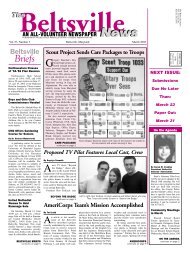Briefs - Beltsville
Briefs - Beltsville
Briefs - Beltsville
You also want an ePaper? Increase the reach of your titles
YUMPU automatically turns print PDFs into web optimized ePapers that Google loves.
Page 12 • The BELTSVILLE NEWS • JULY 2005<br />
JIM STACY<br />
continued from page 1<br />
of Jim’s youth.<br />
Scout summer camps and an<br />
unforgettable week at the great<br />
Philmont Scout Camp in New<br />
Mexico hold special memories for<br />
Jim Stacy. As an adult, just as<br />
Stacy’s sons Russell and Clark<br />
were approaching Scouting age,<br />
Jim became Scoutmaster for <strong>Beltsville</strong>’s<br />
venerable Boy Scout Troop<br />
1033, sponsored by the Emmanuel<br />
United Methodist Church. Succeeding<br />
the enormously successful<br />
Ted Ladd, whose leadership turned<br />
out a steady stream of newly minted<br />
Eagle Scouts, Stacy quickly<br />
put his own stamp on Troop 1033.<br />
During a 10-year span as Scoutmaster,<br />
Stacy would see 17 Troop<br />
1033 Scouts, including both sons,<br />
elevated to Eagle rank. He would<br />
take the Troop to nine weeklong<br />
summer base camps and three trail<br />
camps at the Goshen Scout Camp,<br />
in Virginia. It might have been<br />
the apex of his Scouting career,<br />
Stacy returned to Philmont for a<br />
week in 1992 as an adult leader<br />
who had been specially selected<br />
by National Capitol Area Council<br />
Boy Scouts of America. He was<br />
delighted to see the great Philmont<br />
Scout camp again, this time<br />
through the eyes of an adult Scout<br />
leader.<br />
Asked why he values Scouting<br />
so highly, Stacy goes through the<br />
usual litany of boys learning organization<br />
and leadership, etc., etc.<br />
But he and long-time Assistant<br />
Scout Master Paul Kepple, who<br />
overlaps the tenure of both Ladd<br />
and Stacy, will quickly tell you the<br />
greatest lifetime benefit for young<br />
Scouts may be the social skills that<br />
they learn. In the outdoors, boys<br />
basically are on their own—there’s<br />
no readily available mom or dad to<br />
run to, no sympathetically minded<br />
classroom teachers to hear sad<br />
stories, no kindly Uncle Bob to<br />
���������������������<br />
���������������������<br />
��<br />
��<br />
�������<br />
�������������������������������������������<br />
�������������������������������������������������<br />
������������������<br />
������������������������<br />
�����������������������<br />
���������������������<br />
��������������<br />
��������������������<br />
��������������������<br />
�������������������������������������<br />
Left to right: Ted Ladd, Eagle Scout Mike Williams, Jim Stacy,<br />
and Paul Kepple.<br />
smooth over bruised feelings with<br />
a quick trip to the local ice cream<br />
emporium. Instead, Scouts, under<br />
the benevolent eyes of leaders<br />
like Jim Stacy, learn to socialize,<br />
to grow with their peers. That’s<br />
what Scouting really is all about<br />
according to Stacy-boys learning<br />
to live, to adapt, to grow together<br />
into well-rounded young men.<br />
Jim and Sara Stacy are about<br />
as Beltsvillian as it gets. Both<br />
studied for six years at High Point,<br />
graduating in 1960. The school<br />
was a junior high and a senior<br />
high in those days. Sara is the<br />
daughter of the <strong>Beltsville</strong> Agricultural<br />
Research Center’s Wallace<br />
Bailey, who still lives in the family<br />
home on Howard Road. Jim,<br />
the immigrant, having come over<br />
from Takoma Park, now has lived<br />
here long enough to call <strong>Beltsville</strong><br />
home. They raised sons Russell<br />
and Clark here. All four members<br />
of the Jim Stacy family now hold<br />
degrees from the University of<br />
Maryland at College Park.<br />
College was a fun time for Jim<br />
Stacy. He learned plenty about<br />
operating a slide rule and lots of<br />
other good stuff. But he learned<br />
nothing about computers, had no<br />
real knowledge of computers, and<br />
had little interest in them. Unbelievable<br />
as it now seems, Stacy<br />
failed to take a single computer<br />
course at the University of Maryland.<br />
He graduated from Maryland<br />
in 1966.<br />
In college, Stacy made sure<br />
there was ample time for the outdoors.<br />
He became active in the<br />
Terrapin Trail Club, an informal<br />
group dedicated to rock climbing,<br />
camping, hiking, and spelunking<br />
through dark caves. He still does<br />
all these activities with the exception<br />
of spelunking, which he gave<br />
up for the pleasures of breathing<br />
above-the-surface fresh air.<br />
One year, Jim and two college<br />
buddies packed up their motorbikes<br />
and shipped them to England.<br />
After flying over to London<br />
to recover the bikes, they spent<br />
the next 90 days tooling around<br />
big chunks of Western Europeall<br />
managed on the $3 per day<br />
that they had allowed for food,<br />
gas, and such other incidentals as<br />
renting campgrounds for cooking<br />
and sleeping. Turning bravado<br />
in Germany, each of the buddies<br />
snipped a souvenir hunk of barbed<br />
wire from the notoriously dangerous<br />
fence that then separated East<br />
Germany from the West. Looking<br />
back, Stacy now wonders how<br />
they escaped being shot on the<br />
spot.<br />
After college, Stacy hired on<br />
first as an intern and then permanently<br />
with the Department of the<br />
Army, where he first learned about<br />
computers and computer program-<br />
ming. The life of a computer programmer<br />
wasn’t exactly a walk in<br />
the park in those early days. There<br />
were no monitors, no disk drives,<br />
no desktops, no laptops-only hulking<br />
mainframes featuring banks<br />
of blinking lights were available.<br />
Jim concentrated on general information<br />
technology-which for him<br />
translated into writing computer<br />
programs to track vast quantities<br />
of Army personnel and other<br />
data. One such program required<br />
over 2,000 punch cards. A single<br />
misplaced punch on a card, not to<br />
mention one misplaced card, was<br />
sufficient to wreck an entire data<br />
base program. To acknowledge<br />
that Jim Stacy handles detail well<br />
is to understate the obvious.<br />
During the course of a 32-year<br />
career with the Department of the<br />
Army, Stacy completed numerous<br />
educational and training programs<br />
including: a Masters Degree in<br />
Automatic Data Processing at<br />
George Washington University, a<br />
one-year study program for government<br />
managers at the Massachusetts<br />
Institute of Technology,<br />
and an Advanced Management<br />
Program at the National Defense<br />
University.<br />
And what adventures have Jim<br />
Stacy and wife Sara been up to<br />
in recent years? Well, quite a lot<br />
actually ... A dizzying sample follows:<br />
To celebrate brother Harry’s<br />
retirement, the Brothers Stacy and<br />
two other men organized what they<br />
came to call the Maryland-Arizona<br />
Expeditionary Group. Their<br />
maiden adventure was a 10-day<br />
hiking trip into the Grand Canyon.<br />
No packaged deal, no casual stroll<br />
over the beaten path was good<br />
enough for these hardy guys. No<br />
way! Entering the famous Canyon<br />
from the rugged Kaibab National<br />
Forest, packing all provisions,<br />
they hiked to the Canyon floor,<br />
explored for days, then re-traced<br />
their way out through the National<br />
Forest. The Expeditionary Group<br />
remains active, always ready for a<br />
new adventure.<br />
A bit later, Jim with son Russell<br />
brother Harry took seven<br />
days to hike the challenging John<br />
Muir Trail, in California. The trail<br />
passes through some of the finest<br />
mountain scenery in the United<br />
States. Surrounded by 13,000-foot<br />
and 14,000-foot peaks, lakes, canyons<br />
and granite cliffs, the 211mile<br />
trail runs southward from the<br />
Yosemite Valley, terminating at<br />
14,000 foot-plus Mount Whitney,<br />
the highest peak in the lower 48<br />
states. Their quest to scale Mount<br />
Whitney flamed out when one of<br />
the hikers came down with altitude<br />
sickness at 10,500 feet.<br />
Still later, the brothers (perhaps<br />
succumbing to the tiniest fragility)




